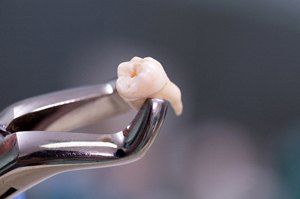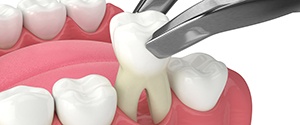

There are several reasons that can signal the need for a tooth extraction but only an experienced dental professional can ultimately decide whether it is a worthy procedure. Dr. Michitti and his team will always look to other potential solutions in an effort to save your natural tooth; however, if any of the following reasons are present and there are no other viable solutions, a tooth extraction might just be the only option:
 When Dr. Michitti examines your tooth, he will need to determine how the tooth
will best be removed. Typically, there are two types of extraction procedures:
simple and surgical. A simple procedure is performed when the tooth is fully
visible above the gum line and can be removed without making incisions. This
is the most common type of extraction.
When Dr. Michitti examines your tooth, he will need to determine how the tooth
will best be removed. Typically, there are two types of extraction procedures:
simple and surgical. A simple procedure is performed when the tooth is fully
visible above the gum line and can be removed without making incisions. This
is the most common type of extraction.
However, if you require a more complex (surgical) procedure, it is because the tooth has either broken off near the gum line or is impacted, which means it has yet to erupt through the gums. This is a much more difficult process, as it can sometimes require an oral surgeon to perform the surgery and can result in more extensive recovery time.
 When you arrive for your appointment, Dr. Michitti will ensure you are
comfortable by numbing the area around your tooth, keeping you pain-free
throughout the procedure. Depending on which type of surgery you’ll be
having, our team will extract your tooth one of two ways:
When you arrive for your appointment, Dr. Michitti will ensure you are
comfortable by numbing the area around your tooth, keeping you pain-free
throughout the procedure. Depending on which type of surgery you’ll be
having, our team will extract your tooth one of two ways:
No matter what type of extraction you have, Dr. Michitti takes extra care to reduce your chances of developing an infection or dry socket after the procedure, but you will need to follow some suggested tips to ensure your recovery period is successful:
 Once your tooth is extracted and you’ve had ample time to heal, the next
discussion will be how to replace it. Missing teeth can cause the bone to
deteriorate, teeth to shift, and changes in your facial appearance. In order
to prevent these from happening, there are several ways you can replace a
missing tooth, including:
Once your tooth is extracted and you’ve had ample time to heal, the next
discussion will be how to replace it. Missing teeth can cause the bone to
deteriorate, teeth to shift, and changes in your facial appearance. In order
to prevent these from happening, there are several ways you can replace a
missing tooth, including:

While having a tooth extracted may be necessary to protect your overall oral health, you should only move forward with the procedure once you have an accurate idea of what the cost will look like. Since there are multiple factors that can potentially influence the amount you pay, our team can only provide you with an accurate estimate once you visit us for your initial consultation. Read on for some important facts about the cost of tooth extractions as well as your options for payment.

Below are some of the variables that we’ll need to consider in order to create a reliable estimate of the cost of your tooth extraction:

Many dental insurance companies will pay at least part of the cost of a tooth extraction. Coverage is often around 50% since an extraction is typically classified as a major procedure. That said, every dental insurance plan is different, and you may need to account for factors such as a waiting period, your deductible, and your annual maximum.
We recommend that you reach out to your dental insurance provider to clarify the details of your plan and what sort of coverage you can expect for a tooth extraction. Additionally, our team can answer any insurance-related questions you might have and can file the necessary claims on your behalf.

We accept a wide variety of dental insurance plans to help our patients save money on tooth extractions and other necessary forms of dental care. However, we recognize that not everyone has dental insurance in the first place. That’s why we also work with CareCredit so that our patients can take advantage of low-interest financing plans that allow them to pay in smaller, more manageable installments. Feel free to speak to our team to learn more about CareCredit financing and how you can apply for it.
We understand that fear of dental pain can prevent many patients from seeking the care they need. However, we want to reassure you that your tooth extraction in Agawam won’t be as uncomfortable as it might seem! We’ll be sure to administer a local anesthetic, which will effectively numb your treatment area. Most patients find that this makes the procedure virtually painless – that said, please let us know if there’s anything else we can do to help you feel more comfortable during your tooth extraction!
Technically, this is an option – however, it’s not recommended. Dental gaps, even in the back of your mouth, can make it harder to chew and speak properly, and tend to cause discomfort due to an uneven bite. Additionally, without a replacement to fill in the socket, that area of your jawbone will miss out on important stimulation and will eventually deteriorate. It’s usually in your best interest to get a tooth replacement as soon as possible.
We strongly discourage smoking or indulging in other tobacco products during your recovery. The chemicals in such products slow down your body’s healing process and increase your likelihood of developing an infection.
If you struggle with a smoking addiction or have had difficulty stopping in the past, please let us know. We won’t judge – we simply want to help you have a smooth recovery and can provide useful resources and tips.
On average, it can take between six to eight weeks to provide you with dentures. That includes your recovery time, returning to the office to get impressions, customizing your dentures, and ensuring they fit properly. It might seem like a detailed process, but it will be worth it for comfortable, quality dentures!
Great question! Being prepared for your tooth extraction can help the treatment go smoothly and reduce anxiety. Here’s what we recommend:
You can also ask our team for more suggestions over-the-phone or in-person. We’ll be happy to help you feel prepared for your tooth extraction in Agawam!